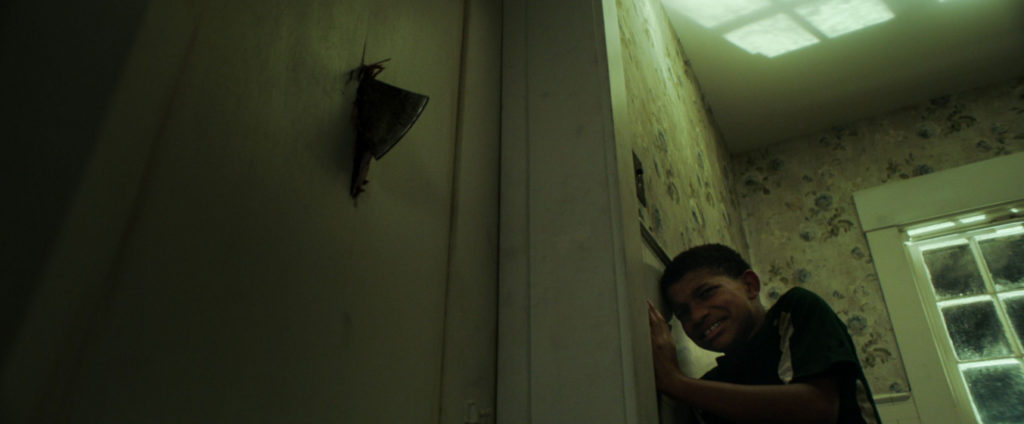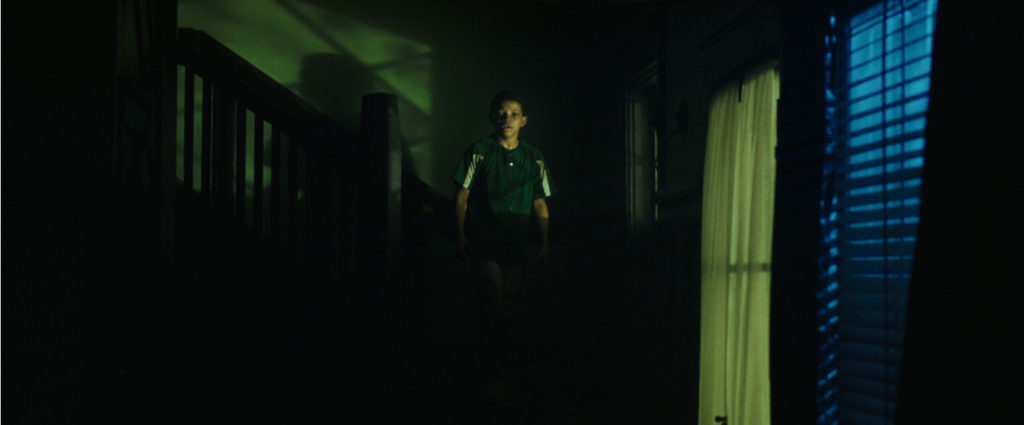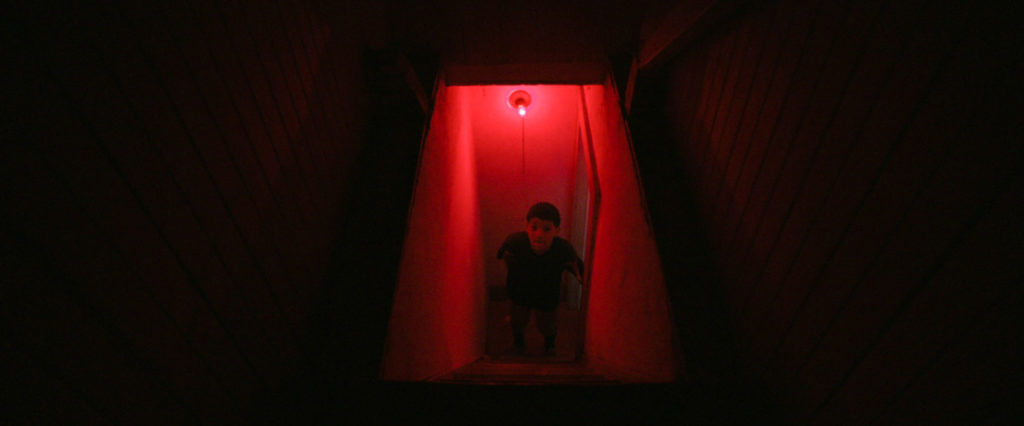Hours before its world premiere at Fantastic Fest, I watched THE BOY BEHIND THE DOOR. I was holding my breath, clutching my throat (with my heart in it for most of the film), sitting on the edge of my chair (which I almost slipped off of), even yelling at the screen a couple of times, and all while reveling in the seductive cinematography and some powerful performances by Lonnie Chavis and Ezra Dewey. What a heartstopper! The fear, tension, and terror are relentless and beyond palpable. We are with Chavis’ character of Bobby every step of the way as he tries to save his friend. We are in the shoes of these 12-year old boys, as well as in their heads and hearts, every step of the way.

Bobby and Kevin are best friends. Their motto is “friends to the end.” Just watching them appreciate the sunny day and just be kids and friends on their way to their Little League game brings a smile to your face. But then the unthinkable happens. Kevin goes to find a baseball that Bobby overthrew as they were practicing some pitching and catching. When he doesn’t return, Bobby goes to look for him. A sudden flurry, an arm, cut to black. When we next see Bobby, he is duct-taped and locked inside a car trunk. Alone. But where’s Kevin? Kevin isn’t there. As Bobby struggles to free himself, we see and feel his determination and resilience, and his concern for his friend. Once free, he looks for Kevin and calls to him but there is no response and no sight of him. As Bobby heads off to get help, he suddenly hears Kevin’s screams. Does he keep going to find help or does he stay and try to find and save Kevin? For Bobby, the decision wasn’t that difficult. He had to stay and help Kevin – no matter what.
Let’s start with the story and the fact that co-writers/co-directors David Charbonier and Justin Powell do the unexpected – they keep us with Kevin and Bobby 100% of the film. There is no outside look at parents wondering where the boys are as nightfall comes, or why no one was looking for them when they didn’t make it to their Little League game. Charbonier and Powell leave the outside world outside and completely immerse us with the POV of Kevin and Bobby. Unexpected and smart storytelling.

But focusing just on the boys means they have to up the ante to keep the audience’s interest, and up the ante they do as not only do we have sole focus with the boys’ POV, particularly that of Bobby as he is our eyes and ears, but the location is contained within one property boasting a large house and a garage/barn, providing plenty of opportunity for set-ups of predicaments for a rescue mission as well as visual interest. Stairs, hallways, windows, closets, doors within doors provide so much visual intrigue which cinematographer Julian Estrada takes full advantage of. A particularly visually expressive scene has a petrified Bobby sneaking past the windows and the door in the living room. The light changes with diffusion and the type of light coming through the windows as he walks that walk. We have bright glaring white light, almost like that of a full moon, diffusing through an organza or chiffon curtain which then morphs to a yellowish bug-lightbulb tinge and then the blueish beauty and safety that comes from a half window that gives a sense of a moment of safety because of the minimal window space. That changing light creates sensory emotions. Very tactile. And setting it all off is the dark woods of the house, the walls, the ebony of the wood floor and staircase.
With no real lighting turned on in the house, negative space comes into play and Estrada dazzles. Neither Bobby nor the audience knows what lurks in the shadows. Some gorgeous judiciously executed and placed ECU’s of Bobby hiding behind a narrow bearing wall between rooms in the foyer and living room speak volumes. We never really get full focus of what’s in the house in terms of furniture until late in the game because Bobby is so focused on his panic and fear and in getting to Kevin, that he is oblivious to what is “in the house.” The use of close-ups and ECUs is thoughtful and telling.

Overall, there is a wonderful rich inky blue-black slick tone to the night and the house itself which is punctuated by the heat of the deep golden yellow that surrounds Kevin in his prison and the red blood that emerges infrequently be it all over the kitchen floor, with the cut of a knife, the severing of a finger, a red of lightbulb, or the red recording light on a camera. Color is striking and telling. Keeping in line with the unseen, Charbonier and Powell keep us in the dark as long as possible, taunting us as to “who” took the boys and why. We see hands on a doorknob. A watch with an alarm set. Feet. And all of these snippets are seen at an angle relatively waist high, like that of a young boy crouched and hiding. Tonal shifts happen within the kitchen which has white-washed walls and cabinets, a stark contrast to the darkness that permeates the rest of the house. And it’s in that kitchen, in the “light”, where Bobby momentarily breaks his focus on finding and freeing Kevin as he is faced with his own survival at the hands of a kidnapper. All of Estrada’s work showcases Ryan Puckett’s production design and the house itself. We are on tenterhooks, white-knuckling every corner, every closet, every dark room within the house, all of which serve to fuel the fear, tension and terror.

But the heart and power of this film is Kevin and Bobby. Friends to the end. They never give up on each other and go to greater lengths for each other than most adults would. The friendship is genuine, heartfelt, real, tangible. The emotion beyond palpable. And the performances by Lonnie Chavis and Ezra Dewey are through the roof. Chavis is onscreen probably 95% of the film, and much of it alone. The bulk of this film rests on his young shoulders. On the other hand, Dewey has some incredibly difficult and intense scenes that even the most seasoned actor would find challenging. He performs them beautifully.
A wonderful emotional and tonal shift occurs late in the game as we see a shift in the emotional strength of the boys with Kevin now more or less taking the lead with the weight of survival more equitably shared versus Bobby shouldering the load due to Kevin’s imprisonment. Lonnie Chavis is a powerhouse of emotion. Period. He has an intensity that is balanced with anxiousness and fear. Ezra Dewey is a surprise with the fortitude he brings to Kevin in the third act. But again, his fear is beyond palpable. And both boys use their heads, but are motivated by their hearts and their friendship.

Fine supporting performances come from Micah Hauptman and Kristin Bauer van Straten.
There are quite a few surprises within the film and we find Charbonier and Powell tackling some difficult societal issues, but doing so through the eyes of the young victims. Key to some of the harder aspects of the film is how tasteful and respectful the filmmakers are in telling the darker elements of the story while still building tension with every frame, every movement, every word, every moment of silence. And speaking of silence, meticulous attention is paid to the sound design thanks to sound designer William McGuigan and his team. From relishing in cacophonous silence that is so loud one can hear a bead of sweat drop to the squeak of the toe of a rubber-soled sneaker on a wood staircase to Kevin’s piercing screams for help, sound is a key component in building the resonant terror and tension.
Editor Stephen Boyer excels at not only finding proper pacing but building tension and releasing it, holding images for full effect without overkill. And he makes the most of some lighter moments in the film that let everyone take a collective breath as Bobby is stumped by a rotary phone, or ventures to use an axe a la Kate Winslet in Titanic to free Kevin from locks and chains. And many of the defensive moves of the boys we see unfold are a nice nod to Home Alone. These authentic little moments within the script, along with playing Little League, tell us exactly who Kevin and Bobby are and eliminate the need for exposition.

Icing on the cake is a beautiful score by Anton Sanko.
There are a few holes in the story itself that appear primarily in the third act, but they are secondary when looking at the overall film and strength of the story, the power of the performances, and the beautiful and telling visual tonal bandwidth that brings it all together under a captivating cinematic umbrella. A more than impressive feature film debut for David Charbonier and Justin Powell, THE BOY BEHIND THE DOOR, and the friendship of Kevin and Bobby will stay with you long after the film ends.
Written and Directed by David Charbonier and Justin Powell
Cast: Lonnie Chavis, Ezra Dewey, Micah Hauptman, Kristin Bauer van Straten
by debbie elias, 09/26/2020











